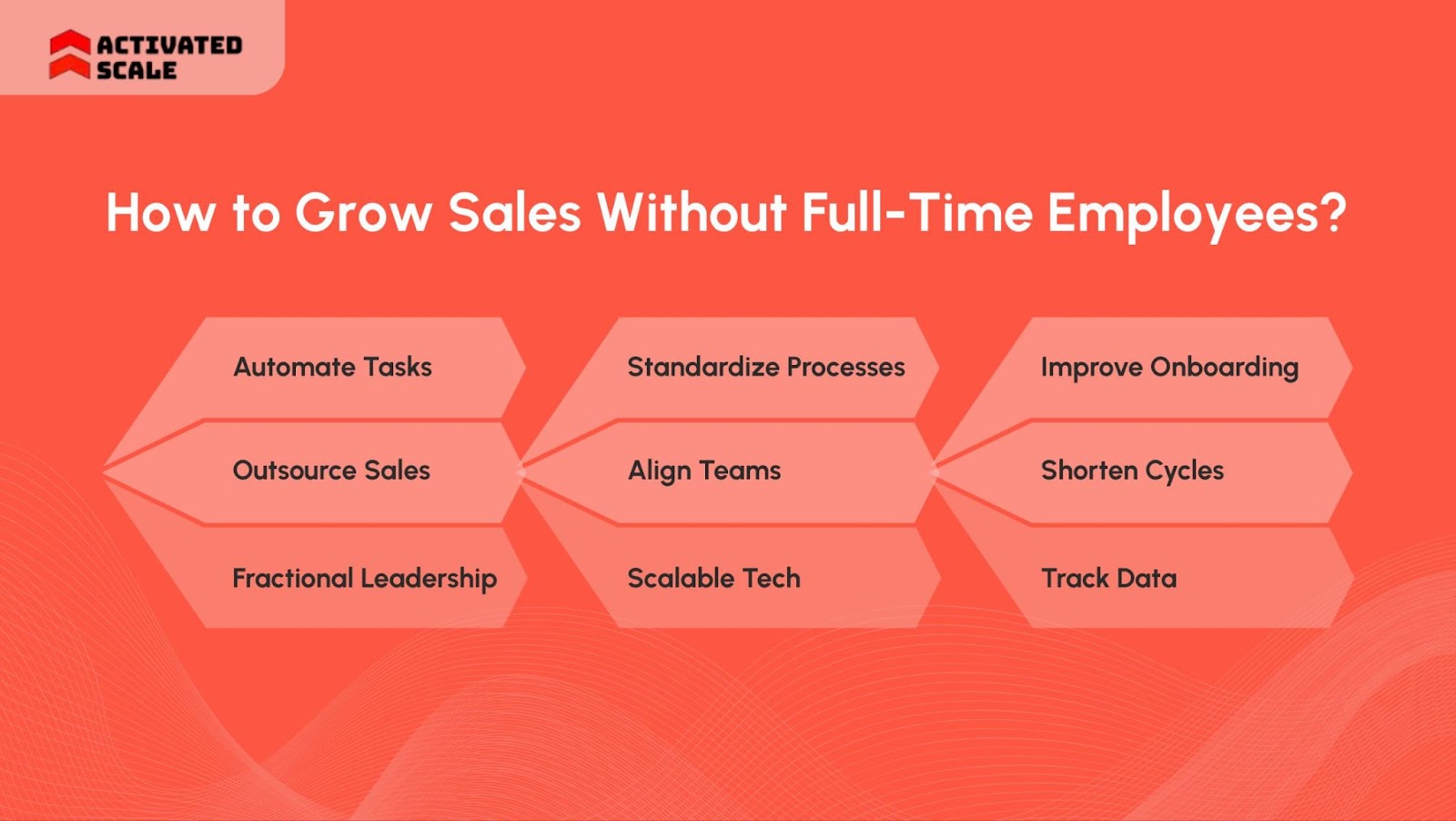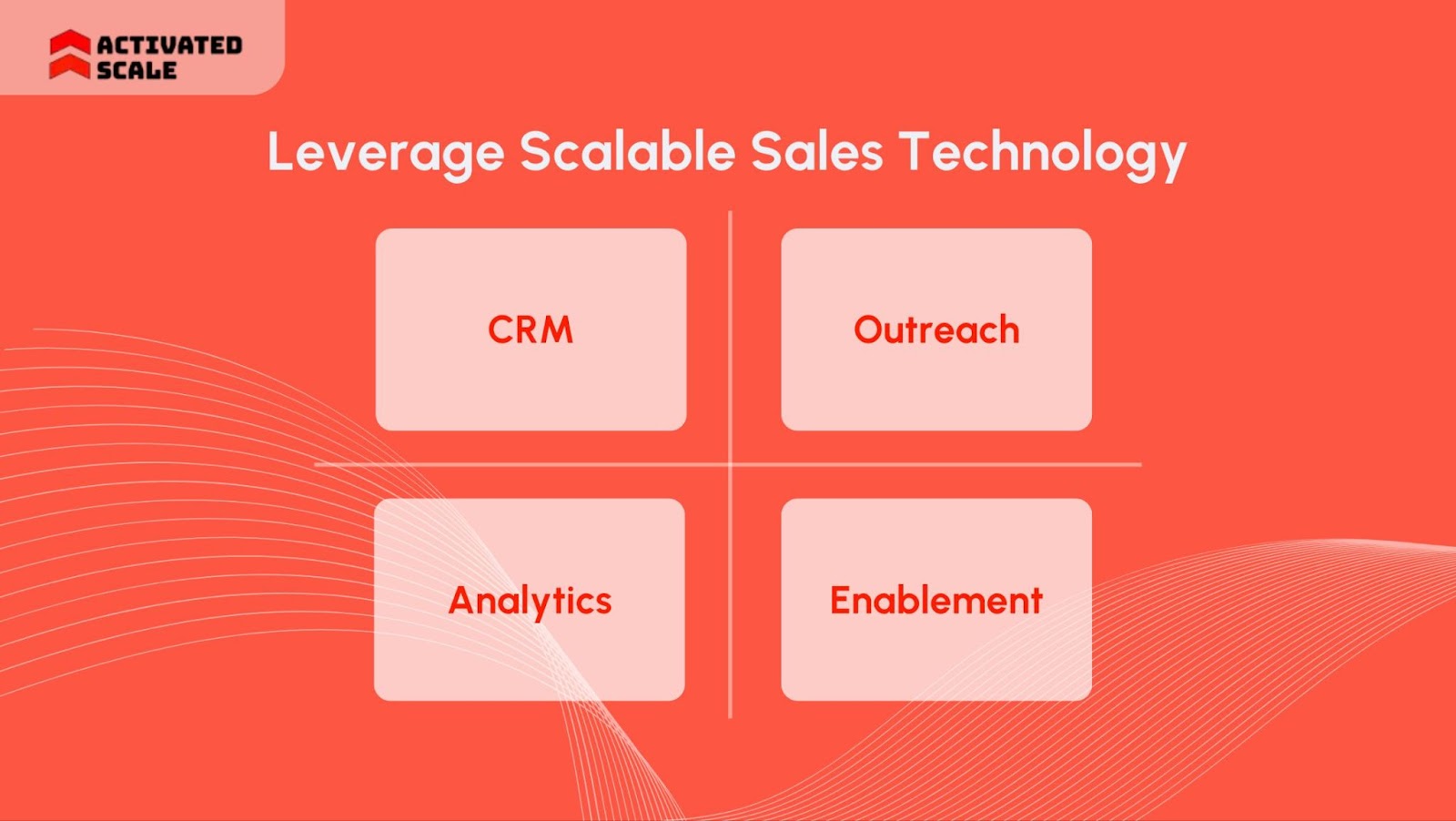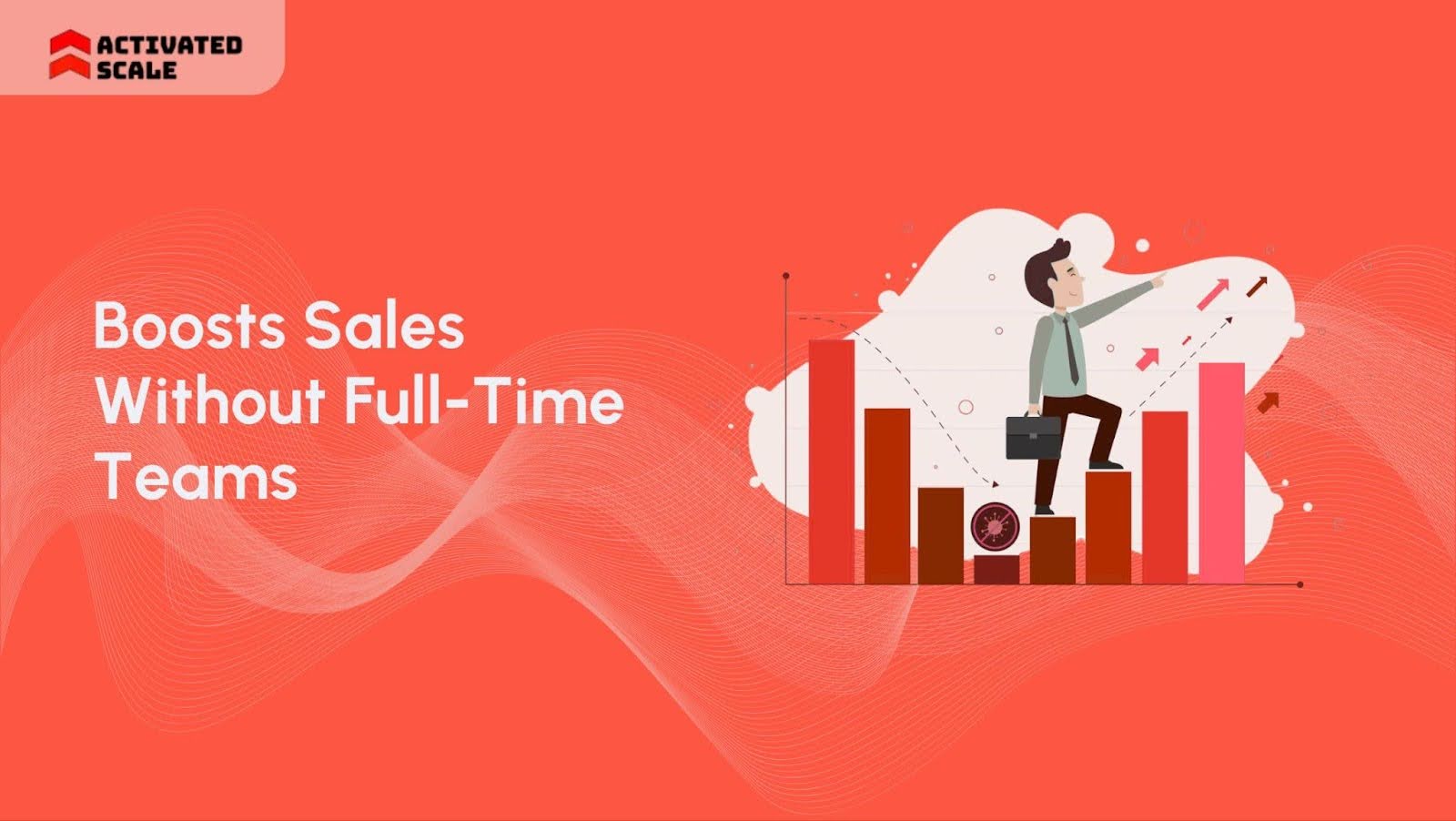67% of sales teams didn’t expect to meet their quota in 2024. That’s not just a number; it’s a signal. Traditional sales hiring models are breaking under pressure.
The cost of hiring, onboarding, and retaining full-time representatives continues to rise, while results don’t scale proportionally.
We get where you're coming from. Building a pipeline shouldn’t mean burning cash or slowing momentum.
In this blog, you'll learn how to approach scaling sales without full-time hires using proven, flexible methods that reflect today’s constraints.
We’ll show you what’s working for teams like yours. Now, you can grow your pipeline without overcommitting on headcount.
TL;DR
- You can scale sales without hiring full-time reps using automation, outsourcing, and smart sales systems.
- Use fractional roles, like SDRs or VPs of Sales, to close execution gaps without long-term contracts.
- Speed matters more than size. Shortening cycles and reducing friction often beats growing headcount.
- Strategic partnerships and shared data rhythms can multiply the pipeline without adding internal pressure.
- Track what matters. Lean teams win when decisions are based on real-time insights, not guesswork.
What Does Scaling Without Full-Time Hires Mean?
Scaling doesn’t always need a flood of new hires. Many sales teams grow revenue using flexible, modular resources. These include outsourced reps, part-time experts, AI tools, and automation.
The goal is consistent pipeline growth without long-term hiring commitments. This matters most when the budget is tight, or headcount approval is slow. Teams avoid burnout by focusing on efficiency, not just expansion.
Scaling sales without full-time hires also improves adaptability. You can test new markets, pilot new segments, or cover gaps without making permanent changes. That agility gives you room to grow without getting stuck in hiring cycles.
However, the process is not without its challenges. To stay ahead of the curve, you need to know how to handle those hurdles strategically.
Also Read: Why Startups Should Consider Fractional Sales Talent?
How to Scale Sales Without Full-Time Hires?

Scaling today is all about output. If your team fails to generate revenue, then it’s time to rethink your plan. The following nine strategies show how to grow without permanent hires:
Strategy 1: Automate Repetitive Sales Tasks
Reps lose hours every week on tasks that don’t close deals. Manual follow-ups, lead sorting, and CRM updates all drain energy from selling.
Automation solves that.
Instead of adding a full-time headcount, many teams use tools to handle repetitive work at scale. This creates more bandwidth without increasing payroll. Here’s what you can do:
- You can automate tasks like lead enrichment, outreach sequences, and performance reporting.
- Tools like Apollo.io and Zeliq help with lead data and outbound campaigns. Use HubSpot Sequences for automated follow-ups.
- Lucep handles AI-assisted calls and routes leads instantly.
High-performing teams are 2.3x more likely to use automation effectively. That’s why scaling sales without full-time hires starts with tech, not talent.
Strategy 2: Outsource Sales Development
Not every pipeline problem needs a full-time Sales Development Representative (SDR). Many high-growth teams now plug in outsourced partners to keep costs low and output high.
Outsourced SDRs or Account Executives (AEs) can manage outreach and early discovery without straining internal bandwidth. Below are the ways you can make it work:
- Test new Ideal Customer Profiles (ICPs) or enter new markets without long ramp-ups
- Fill outbound gaps while closers focus on deals
- Support campaigns with fast follow-up and scalable coverage
Choose partners who have experience in your sales motion and offer clear reporting. Look for flexible models, such as monthly, quarterly, or milestone-based.
The right partner will work like an embedded team. That’s where Activated Scale stands out.
- Contract-to-Hire Sales Recruiting: Try vetted professionals before committing to full-time
- Fractional Selling: Fill gaps with experienced Sales Development Representatives (SDRs) and Account Executives (AEs); no full-time headcount is required
- Fractional Sales Leadership: Bring in part-time sales leaders to build playbooks and Go-to-Market (GTM) systems
Outsourcing is a smart way to scale, especially when speed and confidence are non-negotiable.
Strategy 3: Use Fractional Sales Leadership
Most early-stage sales teams need strategic direction but can’t justify a full-time VP of Sales. That gap slows growth more than missing reps ever will.
Fractional sales leaders give you senior expertise without locking into high-cost, long-term contracts. You get access to proven operators who’ve built GTM engines and scaled teams without hiring full-time. Skills they bring to the table:
- Design territory and comp plans
- Build and document repeatable sales playbooks
- Select and implement the right sales tech
- Coach existing reps and run weekly deal reviews
- Fix funnel gaps from top to bottom
Activated Scale helps companies scale faster with experienced Fractional VPs of Sales. These leaders align the right tools for your team. Contact us today to get started.
Strategy 4: Build Repeatable Sales Processes
A scattered sales process creates unpredictable outcomes, even with good reps. Repeatable workflows give your team structure, speed, and confidence. Core processes to standardize:
- Lead handoffs from marketing to sales
- Qualification frameworks (like BANT or MEDDIC)
- Follow-up timelines and email templates
- Discovery call structure and objection handling
- Proposal and closing checklists
Document these in one place, train consistently, and track adherence. This turns individual effort into team-wide impact.
Top-performing reps are 5.88x more likely to use structured methodologies. This results in quicker handoffs, fewer delays, and more consistent deal progression.
Also Read: How can you build a sales process at your startup?
Strategy 5: Align Sales with Marketing
Sales and marketing often chase the same goals with different playbooks. That disconnect leads to wasted leads and missed opportunities. This is how alignment looks like:
- Shared definitions for Marketing Qualified Lead (MQLs) and Sales Qualified Lead (SQLs)
- Regular handoff syncs and feedback loops
- Unified messaging across email, content, and calls
- Joint campaign planning and performance reviews
When both teams work from the same data and goals, the pipeline grows without friction. Research shows that aligned teams grow revenue 15% faster.
Strategy 6: Use Scalable Sales Tech

You don’t need a big team to run a powerful sales operation. The right tools help small teams punch above their weight. Scalable tech frees reps from manual work and supports faster decision-making across the funnel. Tools that deliver more with less efforts:
- CRM: HubSpot or Pipedrive for clean, automated pipeline tracking
- Outreach: Apollo, Lemlist, or Instantly for multichannel prospecting
- Analytics: Databox or Clari for deal forecasting and performance reviews
- Enablement: Loom or Notion for internal playbooks and async coaching
Choose tools that integrate well and require minimal setup. Don’t chase features; prioritize usability and immediate impact.
Tech stack simplicity correlates with better adoption and ROI. That matters when scaling sales without full-time hires; your tools need to act like team members.
Strategy 7: Improve Training and Onboarding
New hires aren’t the only ones who need training. Even lean teams need ongoing enablement to stay sharp and consistent.
You don’t need an in-house trainer to build a great learning process. Here’s how to train without scaling headcount:
- Record core calls and build a library of short reviews
- Use tools like Loom to create async walkthroughs
- Create quick-reference guides in Notion or Google Docs
- Run monthly “mini sprints” to refresh skills or introduce changes
Well-trained teams operate more efficiently and make fewer mistakes.
Strategy 8: Shorten Sales Cycles
Long sales cycles drain resources, especially when your team is small. The longer deals drag, the harder it gets to scale efficiently.
Speed creates leverage. Follow these steps to reduce sales friction:
- Use pre-recorded demos for faster product education
- Send proposals within hours, not days
- Follow up within 24 hours of every touchpoint
B2B buyers choose vendors who respond first, and 63% begin with just one in mind. That makes response time critical. When your sales process runs fast and lean, scaling sales without full-time hires becomes more effective.
Strategy 9: Monitor and Adjust Using Data
You can’t improve what you don’t measure. When your team is lean, every misstep costs more. Tracking data gives you an advantage, not just visibility. Here’s what to track weekly:
- Lead response times and conversion rates
- Funnel stage drop-offs and time-to-close
- Win rates by rep, channel, or ICP
- Campaign ROI and outbound performance
Use simple dashboards. Focus on trends, not just totals. Review weekly as a team; even 15 minutes is enough to catch issues early.
Teams using sales analytics and automation tools are twice as likely to hit their targets. That shows how data-backed processes drive results.
Read Also: Sales Process Optimization: Strategies, Tips, and Benefits to Close More Deals
Conclusion
Hiring more reps doesn’t always mean more revenue. You’ve seen how lean, agile strategies can power serious growth. From automation to fractional talent and partner channels, scaling sales without full-time hires is not just possible; it’s proven.
The key is choosing the right levers at the right time. If you’re ready to grow without overcommitting, our flexible sales at Activated Scale can help you sell smarter.
Book a call with Activated Scale to explore fractional sales leadership to scale sales without full-time hires.
FAQs
1. Can I really scale sales without hiring full-time reps?
Yes. Many high-growth companies use automation, outsourced SDRs, and fractional leaders to grow without increasing headcount.
2. What’s the first step if I want to try this model?
Start by automating your repetitive sales tasks. Then, plug in outsourced or fractional roles where your team has bandwidth gaps.
3. How do I know if I’m ready for a fractional VP of Sales?
If you’re closing founder-led deals but struggling to build a process or team, it’s time to bring in fractional leadership.
4. Will outsourcing affect my brand voice or consistency?
Not if you choose experienced partners. Look for firms like that to build playbooks and align closely with your messaging and tone.
The Ultimate Guide to Hiring a Salesperson!
Get the step-by-step guide to hiring, onboarding, and ensuring success!
_edi.png)




